A huge cluster of stars has been found lurking in the Milky Way, just a relatively short cosmic distance from our own Solar System.
Now around 75 million years old, the open cluster Valparaíso 1 is estimated to have contained around 10,000 solar masses’ worth of stars when it first blazed into existence.
At just 7,000 light-years away, several of its stars are bright enough to be seen through a telescope in your backyard, in a well-explored section of the sky – although, despite this, it somehow managed to escape our notice until now.
Its discovery is a boon, astronomers say, as we finally have solid evidence of a massive open cluster of middling age for its star type, revealing that this ‘missing link’ of open clusters could have simply been evading detection, and quite easily, too.
“Previous searches tried to locate open clusters, but Valparaíso 1 does not look like a cluster similar to those which we usually find, and that is why it was not discovered before,” said astrophysicist Ricardo Dorda of the Instituto de Astrofísica de Canarias in the Canary Islands.
An open cluster is a group of stars born together from the same molecular cloud of gas and dust. They are all of a similar age and chemical composition, and they move together through their home galaxy.
Yet, because Milky Way star distances and galactic orbits can be difficult to work out from Earth, identifying these clusters isn’t always easy.
The region of sky in which Valparaíso 1 is located. (Gabriel Pérez Díaz, SMM (IAC))
Even so, the absence of intermediate-age massive open clusters with more than 10,000 solar masses in size had astronomers scratching their heads.
We’ve found plenty of younger ones, at the age of about 25 million years or less – and a few older ones that are billions of years old – so, there should be more out there that bridge the gap between them.
To that end, a team of researchers went looking, led by astronomer Ignacio Negueruela of the University of Alicante in Chile. They had a powerful tool at their disposal – data from the Gaia satellite, a probe that has spent the last several years mapping the Milky Way in three dimensions with the highest precision yet.
The resulting data doesn’t just include the positions of the stars within the Milky Way, but also their motion, allowing the researchers to determine that the stars of Valparaíso 1 are all moving together as a group as they orbit the galactic center.
With this information in hand, the astronomers turned to other telescopes to determine the peculiarities of the stellar population of the cluster, from a sample of 1,047 stars.
Using the 2.5-meter Irénée du Pont telescope at Las Campanas Observatory in Chile and the 2.5-meter Isaac Newton Telescope at El Roque de los Muchachos Observatory in Spain, they obtained the stars’ light spectra that allowed the scientists to determine their physical properties.
Some of the stars – around 180 – were found to be B-type main sequence stars. These are very hot stars that are typically between two and 20 times the mass of the Sun, with a lifespan between 10 and 100 million years, which is pretty short for a star (the Sun is around 4.6 billion years old and still going strong).
Most of the stars were red giants, a late stage of stellar evolution, in which the stars puff up as they run low on hydrogen.
The discovery suggests that many more massive open clusters may be out there; we’ve simply missed them because of their relatively diffuse structure, and because other similar stars at different distances are obscuring them.
“Valparaíso 1 contains dozens of stars sufficiently bright to be observable through an amateur telescope, but they are lost in the middle of a crowd of stars which don’t belong to the cluster, but which are in front of it or behind it, and which disguise the structure of the cluster,” Negueruela explained.
Future searches using the Gaia data could pony up these missing clusters.
Meanwhile, Valparaíso 1 is a rare trove, representing an opportunity to explore and better understand the intermediate stage of the evolution of open cluster stars, and their home environment. The team hopes to perform follow-up research in much greater detail.
The research has been published in the Monthly Notices of the Royal Astronomical Society.



